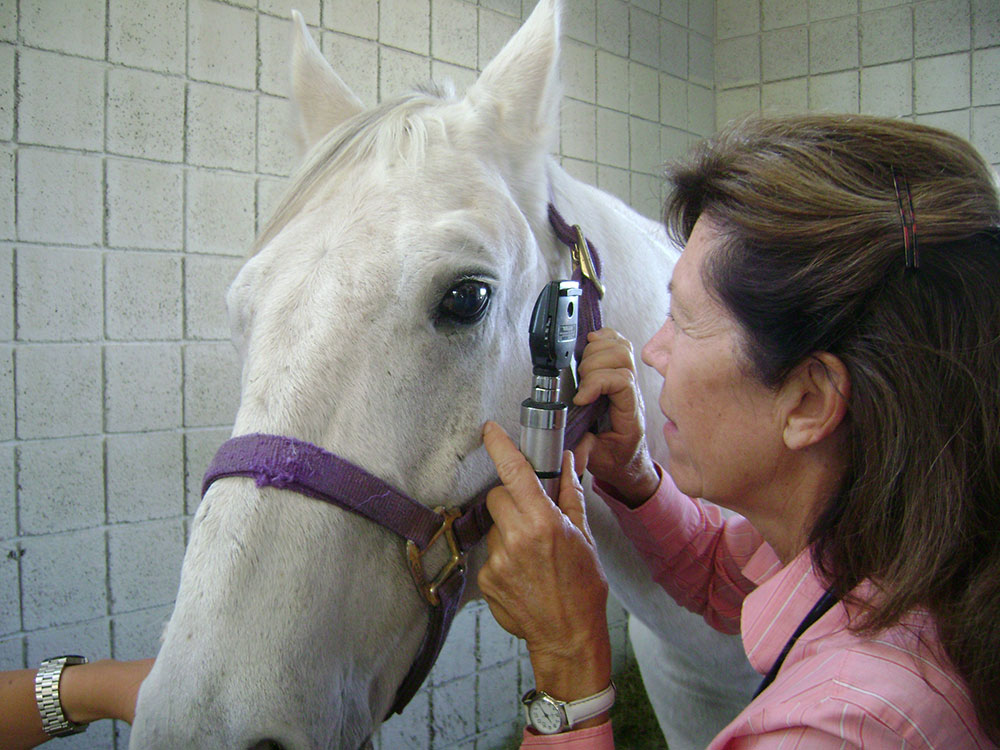
Prepurchase Exams
The prepurchase examination is a critical tool in assisting the potential owner with an impartial view of a horse’s health. This exam will provide insights to ensure that an informed decision is made prior to the final purchase. Ideally, the buyer has tried the horse several times and had a trainer help guide the rider in the determination “that this horse is a suitable mount” for the buyer’s intended purpose. Once your ideal mount has been selected, the veterinarian can consult with the buyer and determine the particular needs and expectations you have for the horse. Once your mount has been selected, the next step is to contact a veterinarian for a through prepurchase examination.
In general, a prepurchase exam will include several phases such as obtaining the horse’s health history, and a detailed physical examination. The prepurchase evaluation includes the following examinations: lameness, ophthalmic, neurologic, respiratory, musculoskeletal, cardiac, oral, general condition, and conformation. Stallion and mare reproductive evaluations can be added to the prepurchase exam if the buyer requests. The lameness exam is performed at rest and following light exercise or riding if need be. Lameness assessment also includes trotting in straight lines/circles, flexion tests, and detailed palpation of the soft tissues of the legs and back.
The prepurchase exam can be divided into several stages, including a health/ performance history, examination in the stall at rest, a physical and lameness evaluation outside of the stall, and diagnostic imaging.
Once the health and performance history has been recorded, a thorough identification of the horse is recorded; this includes color, scars, markings, tattoos (e.g., American Jockey Club tattoos have an alphabet letter before the number; “A” represents the years 1971 and 1997, “B” 1998)., brands, possibly digital photographs, and an approximation of age via dental inspection.
The initial part of the examination often begins in a stall or area out of direct sunlight, dark enough for an ophthalmologic examination. Temperature, auscultation of the heart and lungs, and oral examinations can be done in the quiet confines of the stall. The veterinarian can evaluate the horse’s stall for wood chewing (cribbing), the character of the manure and feed, and/or oral medication remaining in the feed bucket. The horse’s general body condition is assessed. The body condition score (1–9) can be assigned a number from thinness (1) to obesity (9). Scores of 5 to 6 are considered normal. Each of the front and hind hooves are thoroughly examined; mismatching, abnormal foot conformation, dishing, type of shoeing, are recorded. The veterinarian then palpate the limbs, examine the hooves ( hoof testers), perform passive flexion tests, and document all findings.
The third phase of the prepurchase evaluation involves watching the horse move on different surfaces on a straight line and in a circle. The ideal surface is asphalt and if asphalt is not available then hard packed dirt. Walking and trotting the patient on either asphalt or hard packed dirt will exacerbate subtle lameness that may not be obvious in the arena or soft ground. Active flexion tests are performed on the front and hind legs. This exam is simply a test in which the joint is flexed for a period of time and then the horse is jogged away. The degree of lameness and number of steps the horse is lame following the flexion is noted. If an arena is available it may be of benefit to watch the horse being ridden or lounged. Having the horse canter/lope or gallop for 5–10 min will enable the doctor to evaluate breath sounds, auscultate (listen with stethoscope) and perform cardiac auscultation following exercise. The horse is then monitored during recovery. Frequently, the veterinarian will repeat trotting the horse in hand so that any subtle lameness that might have been accentuated during the exercise stage can be detected.
It is also valuable to perform a basic neurologic examination. : A brief neurological exam is performed on the head to make sure the cranial nerves appear to be within normal limits. A neurological evaluation is usually performed during the physical and the musculoskeletal exams. To assess the horse’s ability to move its limbs normally, additional tests are performed. Some of these tests may include moving the horse in tight circles, backing with their head raised high, and stepping over poles. The final portion of the prepurchase exam includes any diagnostic procedures, including digital radiographs (particularly of the feet, hocks, and stifles), digital ultrasonography, MRI, endoscopy, nuclear scans, and blood work. The diagnostic procedures are chosen based on numerous factors (problems detected during the examinations, purchase price, client preferences, etc). Radiography is the most common diagnostic procedure performed. Arizona Equine Medical and Surgical Centre has portable computerized and digital radiographic equipment. All diagnostic test results can be emailed to the buyer’s veterinarian if requested.
State and international disease testing will be reviewed with the buyer. Drug testing will be offered to the buyer and its limitations discussed. If the horse is purchased at a competition, or the seller is not known to the buyer, drug testing is strongly recommended. Even when a buyer does not wish to have drug testing, the Arizona Equine veterinarians highly recommend collecting blood at the time of the examination and storing the serum for approximately one month. The serum will be available for that month if any questions arise after the purchase.
The Arizona Equine veterinarians will provide a detailed summary report. The report will provide a review of all the systems examined, diagnostic procedures performed, and laboratory results. The ultimate goal of the Arizona Equine Medical and Surgical prepurchase exam is to provide detailed information that will enable the buyer to make an informed decision.
Again, it should be emphasized that the purpose of a prepurchase examination is to tell the potential buyer of any problems the horse CURRENTLY has. It is difficult, if not impossible, to predict which horse will develop lameness or other problems in the months to years after a purchase has been concluded.


